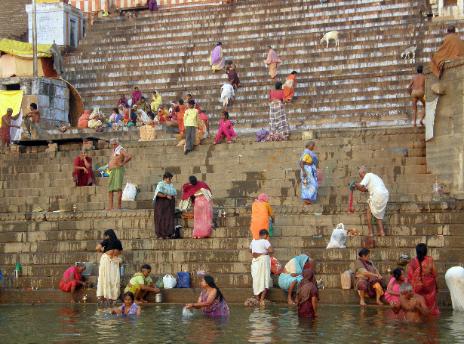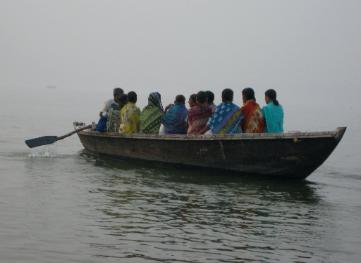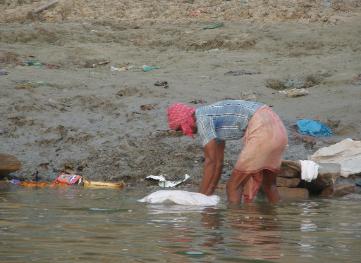|
|
When this year long trip was no more than a spark in the corner of our minds over a year ago, Jarrod and I went
to dinner with his cousin April. She and her husband traveled extensively in India a few years back and we were
eager for her insight and advice on how to spend our four weeks there. April embraced India with open arms and
had endless input on where to go, what to do and what to see. She talked about the time she spent in Mumbai
and the scrumptious street food to be enjoyed there. She talked about the southern state of Kerala and
enthusiastically recommended exploring the miles and miles of backwater canals there. But when she talked about
the city of Varanasi her already lively eyes became brighter and I could feel the energy increase in her voice. I can’t
remember what she said, rather it was the way she spoke of this spiritual city that made an impression on me. I
decided then and there that this was a place that I had to see for myself.
Mark Twain famously described Varanasi as "older than history, older than tradition, older even than legend,
and looks twice as old as all of them put together". It is one of the most spiritual places in all of India if not the
world. Devout Hindu pilgrims come here to wash away their sins in the flowing, albeit toxic, waters of the Ganges
River and to cremate their loved ones and sprinkle their ashes in the river. The western bank of the Ganges River is
the heart of spiritual activity in Varanasi. It is lined with steep stairs, which are called ghats, leading from the edge
of the city down to the waters of the river. Jarrod and I took a pre-dawn boat trip on our first morning in Varanasi
where we saw the most intimate and spiritual of activities taking place just a few feet from the edge of our boat. As
we climbed aboard the boat the only light visible came from small candles floating on the top of the water. These
bundles of flowers and fire are set afloat by Hindus as an entreaty to the gods to bless their family and loved ones.
|
|
|
|
 |
|
|
|
The Varanasi ghats lining the Ganges River
|
|
|
|
We would soon learn that this is also a popular money-making opportunity for some not so pious men who ply the
banks of the river. Over the next three days we were approached countless times by these men who wanted us to
purchase one candle for each of our family members and friends. Doing so would insure their safety and well-being.
Despite our skepticism at the legitimacy of this blessing, the first time we were approached we decided it would be
fun to take part in this local custom. We bought a handful of these flower/candles and thought of all our friends and
family as we lit them and sent them floating down the Ganges River. It wasn’t five minutes later that another
pseudo-religious man approached us and asked us to buy flowers as a blessing for our loved ones. We declined
and tried to continue walking down the riverbank. He followed us, accosting us with such accusations as “don’t you
love your family and want them to be safe?” We came to the realization quickly that although Varanasi was indeed
a very spiritual place, it was still India. And therefore nothing was off limits when the opportunity to make a few
rupees presented itself. Not even guilting a pair of innocent tourists into buying endless blessings for their family
and friends.
|
|
|
|
As our rowboat pulled away from
the bank of the river and began its
slow journey the sun’s first rays
illuminated the activity taking place
along the ghats. The most surreal
scenes played out in front of our eyes,
from devotees bathing, meditating, and
performing ancient rituals to greet the
sun. We watched scores of people
descend into the murky river, taking
water into their mouth and their hands,
and then returning it back to the river,
as part of the ritualistic cleansing
process. Further down the river we
came upon the Manikarnika ghat, the
main cremation ghat. Several piles of
firewood dotted the area around this
ghat, with some of them in full blaze
and some of them no more than
smoldering piles of ash. It is here that
Hindus bring their loved ones to be
cremated and then to sprinkle their
ashes into the Ganges River. We saw
|
|
|
|
 |
|
|
|
|
|
As the sun rises over Varanasi the ghats spring to life.
|
|
|
|
|
|
solemn funeral processions winding their way from the depths of the Old City to this ghat, carrying the body,
shrouded in red, orange, gold or white cloth and adorned with garlands of flowers. The body is first submerged in
the Ganges River as a last cleansing bath. Once the final cleansing is complete, the body is placed on the pile of
specially selected wood. Only male family members and friends are allowed to be close to the body. Women must
watch from an observation deck. It is believed that females will be too emotional and that the soul of the deceased
cannot be released to nirvana if someone is crying out for him in grief. Those surrounding the body circle the body
five times prior to lighting the fire, once for every element (sun, earth, water, air, fire). It is custom for the oldest
son of the person being cremated to light the funeral pyre. Once the body has been reduced to ashes it is sprinkled
into the Ganges River. This is believed to offer the deceased moksha—release from the cycle of birth and death. Not
all Hindus are cremated. Pregnant women, holy men and children, among others, are thought to already be clean.
Needing no purification by fire, their bodies are simply weighted down and lowered into the river.
|
|
|
|
Women in beautiful saris enjoying a morning on the Ganges.
|
|
You might not want to get your laundry cleaned in Varanasi.
|
|
|
|
It was unbelievable that people were bathing and drinking the same water that submerged thousands and
thousands of decaying bodies. It was the first of many baffling questions that plagued our mind. Further down the
river we saw raw sewage flowing into the river from a huge drainage pipe. Directly next to this pipe, dozens of
people washed bedsheets and clothing in the same water. We watched as they submerged the laundry, beat it
against rocks and then laid it on the banks of the river to dry in the sun. It certainly gave us second thoughts
about having our laundry done in Varanasi and made us extra thankful for our protective sleepsheets. Over the
next few days Jarrod and I spent the majority of our time along the banks of this fascinating river. We witnessed
people meditating, practicing yoga, playing the flute, brushing their teeth, washing their buffaloes and playing
cricket in or around the river. Despite the worrisome health issues presented by the toxic water of the Ganges the
overwhelming emotion that Varanasi imparted on us was one of spirituality. We feel honored to have seen these
religious rituals and to have the opportunity to learn more about the Hindu religion. Our three days in Varanasi
came to an end all too quickly. I think it is likely that everyday in this fascinating city presents a new and unique
sight to behold and we could stay for a year and not grow tired of seeing sadhus (holy men who have renounced
all worldly possessions) painted in tribal like colors ply the riverbanks, watching the prayers complete with
complicated fire rituals take place each evening, and hearing the hum of life that is Varanasi eminate from the
Ganges River.
|
|
|
|
return to india overview next india journal>
|
|
|
|
|
|
|
|
|





